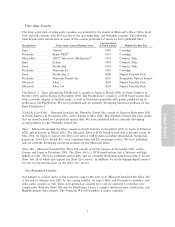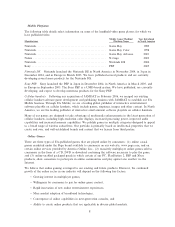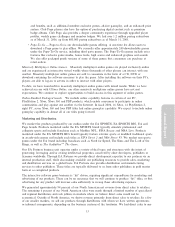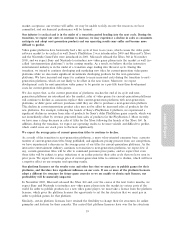Electronic Arts 2006 Annual Report Download - page 81
Download and view the complete annual report
Please find page 81 of the 2006 Electronic Arts annual report below. You can navigate through the pages in the report by either clicking on the pages listed below, or by using the keyword search tool below to find specific information within the annual report.
Competition
We compete in the entertainment industry. At the most fundamental level, our products compete with
other forms of entertainment, such as motion pictures, television and music, for the leisure time and
discretionary spending of consumers. We believe that the software games segment is best viewed as a
segment of the overall entertainment market. We believe that large software companies and media
companies are increasing their focus on the software games segment of the entertainment market and, as a
result, may compete directly with us. Several large software companies and media companies (e.g.,
Microsoft and Sony) have been publishing products that compete with ours for a long time, and other
diversiÑed media/entertainment companies (e.g., Time Warner, Viacom, Fox and Disney) are expanding
their software game publishing eÅorts.
The software games business is highly competitive. It is characterized by the continuous introduction of
new titles and the development of new technologies. Our competitors vary in size and cost structure from
very small companies with limited resources to very large, diversiÑed corporations with greater Ñnancial
and marketing resources than ours. Our business is driven by hit titles, which require ever-increasing
budgets for development and marketing. As a result, the availability of signiÑcant Ñnancial resources has
become a major competitive factor in developing and marketing software games. Competition is also based
on product quality and features, timing of product releases, brand-name recognition, quality of in-game
content, access to distribution channels, eÅectiveness of marketing and price.
Games for Consoles, PCs and Handheld Video Game Players
We currently compete with Sony, Microsoft and Nintendo, each of which develop and publish software for
their respective console platforms. We also compete with numerous companies which are, like us, licensed
by the console manufacturers to develop and publish software games that operate on their consoles. These
competitors include Activision, Atari, Capcom, Koei, Konami, LucasArts, Midway, Namco, Sega, Take-
Two Interactive, THQ, Ubisoft and Vivendi Universal Games, among others. As discussed above,
diversiÑed media companies such as Time Warner, Viacom, Fox and Disney are also expanding their
software game publishing eÅorts.
In addition to competing for product sales, we face heavy competition from other software game
companies to obtain license agreements granting us the right to use intellectual property included in our
products. Some of these content licenses are controlled by the diversiÑed media companies, which, in some
cases, have decided to publish their own games based on popular movie properties that they control, rather
than licensing the content to a software game company such as us.
Annual Report
The market for our products is also characterized by signiÑcant price competition and we regularly face
pricing pressures from our competitors. These pressures have, from time to time, required us to reduce our
prices on certain products. Our experience has been that software game prices tend to decline once a
generation of consoles has been in the market for a signiÑcant period of time due to the increasing number
of software titles competing for acceptance by consumers and the anticipation of the next-generation of
consoles. We have experienced this kind of price erosion during the past twelve months, as the software
game segment has been going through a transition from the current generation of consoles (PlayStation 2,
Xbox and Nintendo GameCube) to the next generation of consoles (Xbox 360, PlayStation 3 and
Nintendo Wii).
Applications for Cellular Handsets
The wireless entertainment applications market segment, for which we develop and publish games,
ringtones and wallpapers for cellular handsets, is highly competitive and characterized by frequent product
introductions, evolving wireless platforms and new technologies. As demand for applications continues to
increase, we expect new competitors to enter the market and existing competitors to allocate more
resources to develop and market applications. As a result, we expect competition in the wireless
entertainment market segment to intensify.
9
























